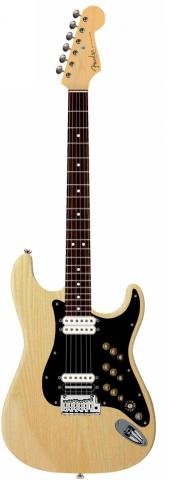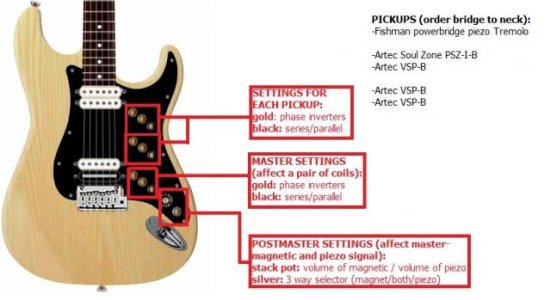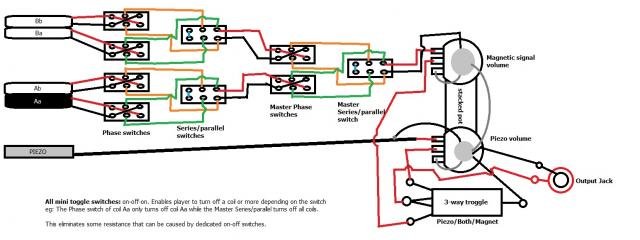A
atrumluminarium
Guest
A few months ago, I posted a thread about Brian May inspired wiring for a metal guitar. As a youngster I was always fascinated by Mr. May's legendary guitar tone which made a Queen song recognisable IMMEDIATELY as it starts playing. I was thinking to build a guitar that would give a similar tone options that he had and could still handle the standard Death Metal guitar tone.
I'm writing this thread to get some feedback from fellow forum members and to share my progressing research and all the opinions of various people to who may have also wished to own a versatile guitar but never had the money to buy one.
I also know that the guitar isn't everything to obtain Brian's tone. I have an Ehx Screaming Bird treble booster and for the moment I can't afford 2 or more Vox AC30 and the maintenance that comes with tube amps.
----------------------------------------------------------------------------------------------------------------------
To start off, I should probably clarify that the type of Death Metal that I play with my band is very progressive and influenced by Prog Death Metal bands like Opeth, Edge of Sanity, Cynic, Atheist, Akercocke, Nile and etc. while also having lots of impact from bands like Queen, Led Zeppelin, Camel, Primus, Deep Purple, etc. so the stuff that we do requires me to be able to change the tone completely, This is OK in a studio environment where you have the time to manipulate your sound as much as you want me being also the self-thought person behind the mixer; but this all changes in a stage environment! So I decided to put my O-level in physics, the 5-hours-a-day I spend watching Discovery Channel and basic woodwork skills to good use, and figure out a way to build a guitar that can:
So now I came up with this guitar design (I used http://www.nymphusa.com/tele/yswtct-kisekae-e.asp and then tweaked it with MS Paint):

Specs (I'll probably buy a cheap Harley Benton build-it-yourself set and use its neck and craft a body with reference to the given one and make it thicker to house the controls with more ease. They only cost about €95 plus you get many spare parts to work with ) :
) :
This is an image showing the switching options and the pick-ups:

Artec VSP-B
http://www.thomann.de/gb/artec_vsp_b.htm
Artec Soul Zone PSZ I-B
http://www.thomann.de/gb/artec_soul_zone_psz_i_b.htm
(just to clarify, they are intended to all be bridge pick-ups)
I'll probably upgrade these to 3 Burns TriSonics and 1 Duncan SSL-6
My philosophy about choosing this pick-up configuration:
For neck:
When switched in series, the neck "humbucker" will compress the signal quite a bit because the coils are identical which in turn gives a little bit more sustain for soloing. The low output level ensures that the signal keeps its treble frequencies intact as much as possible. The reverse phase option is an other thing inspired by Brian May which is rich in harmonics and makes the guitar scream.
For bridge:
The difference in the output level of the coils can give the signal more dynamic range when in series which is good for any fast riffing because the notes are more separated. The high output and alnico magnet are useful for getting more "fatness" as well.
Other possibilities:
Neck in series + the white coil of the bridge in series with the neck: This, in theory should compress the signal further giving more sustain and boost output because all coils are the same. with a hollowed body, it shouldn't lose the high end completely.
All 4 coils in series + piezo: This should give MASSIVE amounts of output and the piezo should return some of the lost high end. I think that it would sound great both on clean because it would be warm while still hearing the "jingle" of steel strings and in high gain would still keep that bite.
Now for the schematic (I apologize for sloppiness :/ ):

I hope the caption in the image is legible :/
Improvements done to previous designs I had came up with to preserve as much tonal value as possible and make the instrument more "user-friendly":
----------------------------------------------------------------------------------------------------------------------
I hope you like what I'm doing so far. The whole thing is going to cost me up to about €700-€800, which will probably take some time to save up for it because I'm still in school but to be honest, I think that it's totally worth it because when a player builds his own guitar, he builds it exactly to his own needs and with ensured quality without having to pay for big names that companies have. It also would be an opportunity to the player to learn more on how his instrument works and find out more what it's capable of doing.
This would also be a good science project (If it's ready by a few months before the deadline I'll probably do the project about it
(If it's ready by a few months before the deadline I'll probably do the project about it  )
)
Before I close this post I would really like to apologize about making you read a lot :15: . I hope you at least found it helpful
Don't forget to post any feedback
:feedback:
I'm writing this thread to get some feedback from fellow forum members and to share my progressing research and all the opinions of various people to who may have also wished to own a versatile guitar but never had the money to buy one.
I also know that the guitar isn't everything to obtain Brian's tone. I have an Ehx Screaming Bird treble booster and for the moment I can't afford 2 or more Vox AC30 and the maintenance that comes with tube amps.
----------------------------------------------------------------------------------------------------------------------
To start off, I should probably clarify that the type of Death Metal that I play with my band is very progressive and influenced by Prog Death Metal bands like Opeth, Edge of Sanity, Cynic, Atheist, Akercocke, Nile and etc. while also having lots of impact from bands like Queen, Led Zeppelin, Camel, Primus, Deep Purple, etc. so the stuff that we do requires me to be able to change the tone completely, This is OK in a studio environment where you have the time to manipulate your sound as much as you want me being also the self-thought person behind the mixer; but this all changes in a stage environment! So I decided to put my O-level in physics, the 5-hours-a-day I spend watching Discovery Channel and basic woodwork skills to good use, and figure out a way to build a guitar that can:
- Change the tone (even completely) by the flick of a switch
- Call on feedback on demand (again Brian May influence :laugh
 for solos making it go from absolutely no sustain to infinite
for solos making it go from absolutely no sustain to infinite - Give great acoustic tones
- Be as light-weight as possible (I deal with minor shoulder strains when I play standing up; although the shape of my current guitar (a Flying-V) really doesn't help :/)
- Be at a reasonable price as much as possible.
So now I came up with this guitar design (I used http://www.nymphusa.com/tele/yswtct-kisekae-e.asp and then tweaked it with MS Paint):

Specs (I'll probably buy a cheap Harley Benton build-it-yourself set and use its neck and craft a body with reference to the given one and make it thicker to house the controls with more ease. They only cost about €95 plus you get many spare parts to work with
- Maple body hollowed out quite a bit with a 3-ply wooden (the type of wood used for fretwork) or a plastic pickguard (depends on which sounds better to my ears) to feedback a little more like Mr.May's and produce a "poppy" sound that seperates the notes better and provide more realistic acoustic tones.
- Medium thick maple neck to sustain and "pop". The thickness is to retain a little more "Fatness" that's lost from the hollowed body. The neck is standard strat scale (25.5") which is unlike Mr.May's (which is 24") but will keep the bass notes tight in a high-gain situation. Tuners are locking.
- Rosewood fretboard jumbo frets with the last 3 frets gradually scalloping deeper so fretting them would be a little bit easier
- Brass Roller Nut for smoother action when using the tremolo and the brass gives a bit more attack http://www.thomann.de/gb/abm_7020c_roller_nut_st_style.htm
- Fishman powebridge tremolo (a piezo pick-up for even better acoustic tones) http://www.thomann.de/gb/fishman_powerbridge_modern.htm
This is an image showing the switching options and the pick-ups:

Artec VSP-B
http://www.thomann.de/gb/artec_vsp_b.htm
Artec Soul Zone PSZ I-B
http://www.thomann.de/gb/artec_soul_zone_psz_i_b.htm
(just to clarify, they are intended to all be bridge pick-ups)
I'll probably upgrade these to 3 Burns TriSonics and 1 Duncan SSL-6
My philosophy about choosing this pick-up configuration:
For neck:
When switched in series, the neck "humbucker" will compress the signal quite a bit because the coils are identical which in turn gives a little bit more sustain for soloing. The low output level ensures that the signal keeps its treble frequencies intact as much as possible. The reverse phase option is an other thing inspired by Brian May which is rich in harmonics and makes the guitar scream.
For bridge:
The difference in the output level of the coils can give the signal more dynamic range when in series which is good for any fast riffing because the notes are more separated. The high output and alnico magnet are useful for getting more "fatness" as well.
Other possibilities:
Neck in series + the white coil of the bridge in series with the neck: This, in theory should compress the signal further giving more sustain and boost output because all coils are the same. with a hollowed body, it shouldn't lose the high end completely.
All 4 coils in series + piezo: This should give MASSIVE amounts of output and the piezo should return some of the lost high end. I think that it would sound great both on clean because it would be warm while still hearing the "jingle" of steel strings and in high gain would still keep that bite.
Now for the schematic (I apologize for sloppiness :/ ):

I hope the caption in the image is legible :/
Improvements done to previous designs I had came up with to preserve as much tonal value as possible and make the instrument more "user-friendly":
- I'm using on-off-on switches instead of on-on-on or on-on to eliminate the need for on-off switches to turn of parts of the chain. This should in turn reduce some resistance (not much but it'll still help) giving off a slightly hotter and fuller signal.
- Because this is a strat and contains lots of space under the pick guard (which I'm going to be hollowing out even further) which can be used wisely. I came across some wire which has a greater cross-sectional area than the standard wires used (it's 5mm in diameter whereas the ones on my Dean VX are 3mm). A thicker wire further reduces resistance to the signal. I'm also going to be using the shortest lengths of wire possible to further reduce resistance.
- I'm using a stacked pot instead of 2 separate ones to make the circuit more compact plus they can be both turned down by one "swipe" on them.
- The locking tuners and roller nut increase the tuning stability when having a tremolo.
----------------------------------------------------------------------------------------------------------------------
I hope you like what I'm doing so far. The whole thing is going to cost me up to about €700-€800, which will probably take some time to save up for it because I'm still in school but to be honest, I think that it's totally worth it because when a player builds his own guitar, he builds it exactly to his own needs and with ensured quality without having to pay for big names that companies have. It also would be an opportunity to the player to learn more on how his instrument works and find out more what it's capable of doing.
This would also be a good science project
Before I close this post I would really like to apologize about making you read a lot :15: . I hope you at least found it helpful
Don't forget to post any feedback
:feedback:
Last edited:
